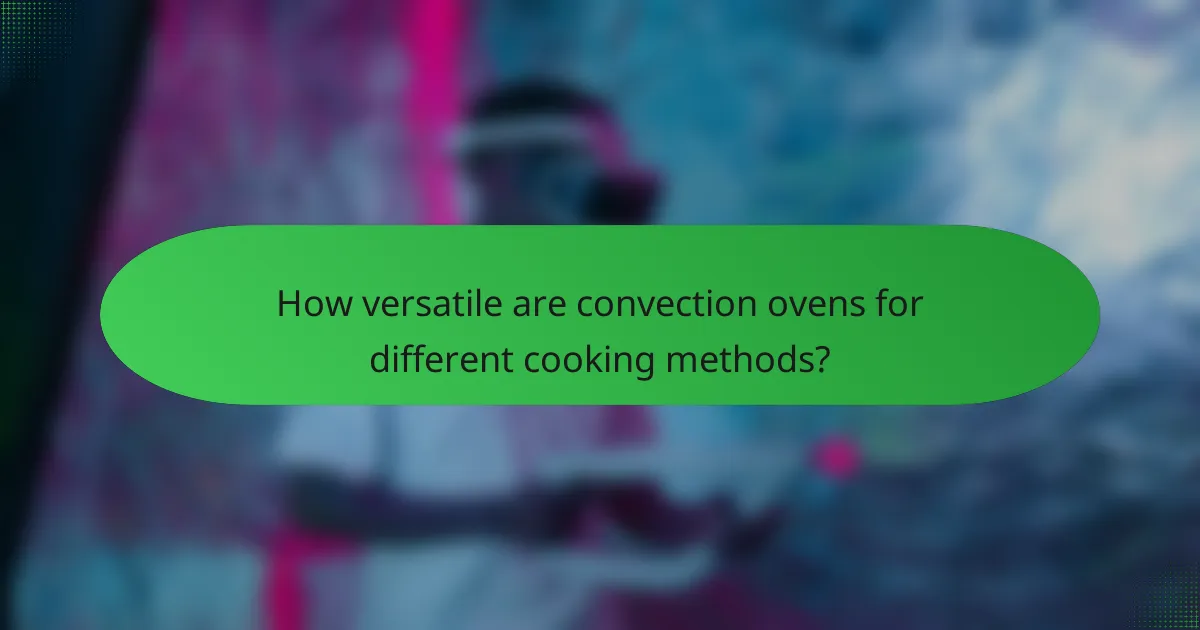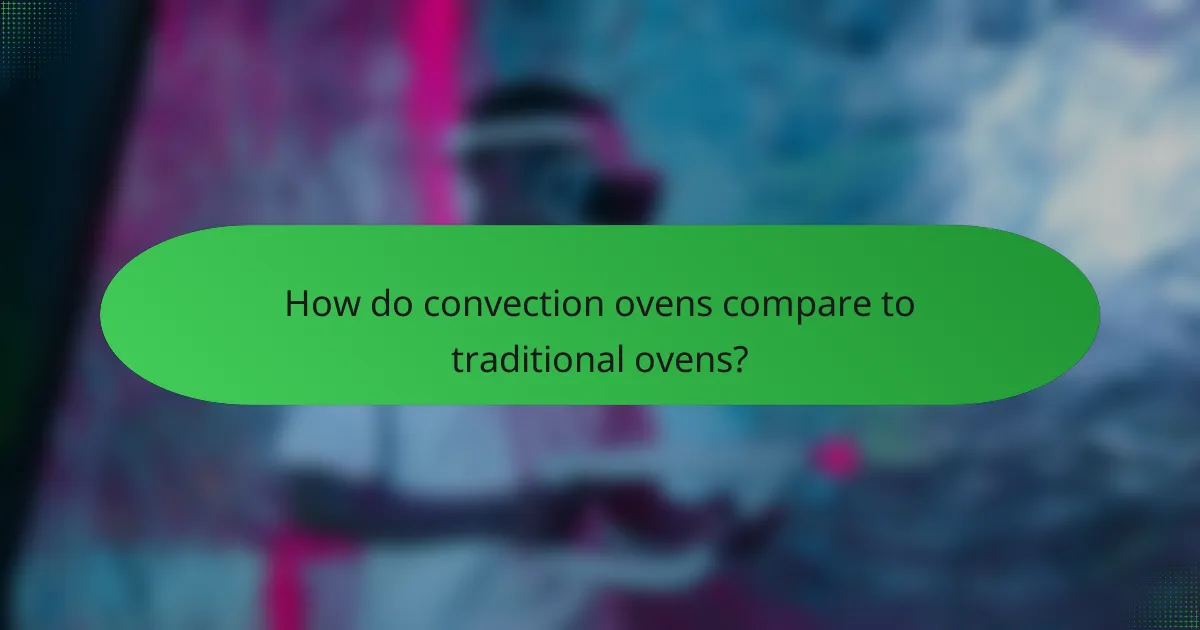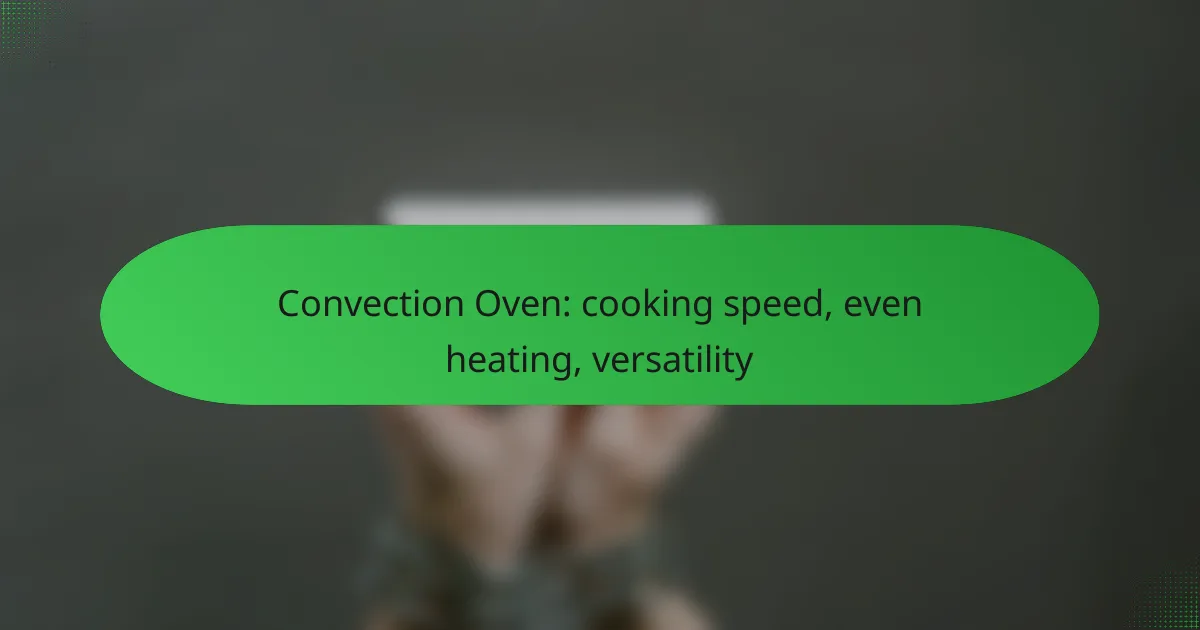A convection oven is an efficient cooking appliance that significantly speeds up meal preparation by circulating hot air with a built-in fan. This technology not only ensures even heating for perfectly cooked dishes but also enhances the versatility of the oven, allowing for various cooking methods such as roasting, baking, and broiling. Ideal for both home cooks and professional chefs, convection ovens deliver consistent results and improved flavor in every dish.

How does a convection oven improve cooking speed in the UK?
A convection oven enhances cooking speed by using a fan to circulate hot air, resulting in more efficient heat transfer. This method not only reduces cooking times but also promotes even cooking, making it a popular choice among home cooks in the UK.
Faster cooking times
Convection ovens can reduce cooking times by approximately 20-30% compared to traditional ovens. This is particularly beneficial for busy households where time-saving is essential. For example, a dish that typically takes 60 minutes may only require 45-48 minutes in a convection oven.
When using a convection oven, it’s advisable to check for doneness a few minutes earlier than the recipe suggests. This ensures that food does not overcook and helps maintain optimal texture and flavor.
Reduced preheating duration
Preheating a convection oven generally takes less time than a conventional oven, often by about 5-10 minutes. The efficient heat circulation allows the oven to reach the desired temperature more quickly. This feature is particularly useful when you need to start cooking immediately.
To maximize this advantage, consider placing your food in the oven as soon as it reaches the set temperature, rather than waiting longer. This can further enhance cooking efficiency.
Efficient heat circulation
The fan in a convection oven ensures that heat is evenly distributed throughout the cooking chamber. This prevents hot and cold spots, allowing food to cook uniformly. As a result, you can achieve consistent results, whether baking cookies or roasting vegetables.
For best results, avoid overcrowding the oven. Ensuring adequate space between dishes allows for optimal airflow, enhancing the cooking process even further.

What are the benefits of even heating with convection ovens?
Even heating in convection ovens ensures that food cooks uniformly, enhancing flavor and texture. This consistent heat distribution is achieved through a fan that circulates hot air, making convection ovens a preferred choice for many home cooks and professional chefs alike.
Consistent cooking results
Convection ovens provide consistent cooking results by maintaining an even temperature throughout the cooking chamber. This uniformity allows dishes to cook at the same rate, reducing the chances of overcooking or undercooking. For example, when roasting meats, convection ovens can yield a perfectly browned exterior while keeping the interior juicy.
Elimination of hot spots
Hot spots are areas within an oven that receive more heat than others, often leading to uneven cooking. Convection ovens minimize these hot spots by using a fan to circulate air, ensuring that all parts of the oven reach a similar temperature. This feature is particularly beneficial when baking multiple trays of cookies or pastries, as it allows for even browning across all items.
Better baking outcomes
Baking in a convection oven often results in superior outcomes due to the efficient heat distribution. Baked goods such as cakes, breads, and pastries tend to rise more evenly and develop a better crust. For instance, when baking bread, the circulating air helps create a crispier crust while maintaining a soft interior, enhancing the overall quality of the final product.

How versatile are convection ovens for different cooking methods?
Convection ovens are highly versatile, accommodating various cooking methods such as roasting, baking, broiling, dehydrating, reheating, and toasting. Their ability to circulate hot air ensures even cooking and faster results, making them suitable for a wide range of culinary tasks.
Roasting and baking
When roasting or baking, convection ovens excel by promoting even heat distribution, which helps achieve a golden-brown finish and crispy texture. The fan circulates hot air, reducing cooking time by about 20-30% compared to traditional ovens. For best results, lower the temperature by approximately 20°F (10°C) to prevent overcooking.
Common items to roast include meats and vegetables, while baked goods like cookies and bread benefit from the consistent heat. Ensure proper spacing on baking sheets to allow air circulation for optimal results.
Broiling and dehydrating
Convection ovens can effectively broil foods, providing a quick, high-heat cooking method that creates a nice crust on meats and vegetables. Position the food closer to the heating element and monitor closely to avoid burning. Adjusting the cooking time may be necessary due to the faster cooking pace.
Dehydrating is another useful function, as the fan helps remove moisture efficiently. Set the temperature low, typically around 130-160°F (54-71°C), and allow several hours for fruits, vegetables, or herbs to dry thoroughly.
Reheating and toasting
Reheating food in a convection oven is quick and effective, preserving moisture while achieving a crisp exterior. Preheat the oven and use a lower temperature to gently warm leftovers without drying them out. This method is particularly beneficial for pizza, casseroles, and baked goods.
Toasting bread or bagels is also straightforward; the even heat ensures a uniform golden color. Keep an eye on the toast to prevent burning, as convection ovens can toast faster than traditional methods.

What features should you consider when choosing a convection oven?
When selecting a convection oven, consider size, energy efficiency, and control options. These features significantly impact cooking performance, energy consumption, and user experience.
Size and capacity
The size and capacity of a convection oven determine how much food you can cook at once. Standard models typically range from 20 to 30 liters, suitable for small families, while larger options can exceed 40 liters for bigger households or batch cooking.
When choosing size, consider your kitchen space and cooking habits. A compact oven may be ideal for limited counter space, while a larger oven offers more versatility for roasting and baking multiple dishes simultaneously.
Energy efficiency ratings
Energy efficiency ratings indicate how effectively an oven uses electricity, impacting your utility bills. Look for ovens with an A or A+ rating, which can save you around 10-20% on energy costs compared to lower-rated models.
In addition to ratings, consider features like programmable timers and automatic shut-off, which can further enhance energy savings. These features help prevent unnecessary energy use when the oven is not in operation.
Control options and settings
Control options and settings affect how easily you can operate your convection oven. Digital controls with pre-set cooking modes allow for precise temperature adjustments and cooking times, making meal preparation straightforward.
Some models offer additional features like steam functions or rotisserie settings, which can expand your cooking repertoire. Ensure the controls are user-friendly, especially if multiple family members will use the oven.

How do convection ovens compare to traditional ovens?
Convection ovens cook food faster and more evenly than traditional ovens by using a fan to circulate hot air. This technology allows for better heat distribution, resulting in improved cooking efficiency and versatility.
Cooking time differences
Convection ovens typically reduce cooking times by about 25% compared to traditional ovens. For instance, a dish that takes 40 minutes in a conventional oven may only require around 30 minutes in a convection model. This time savings can be especially beneficial for busy cooks or when preparing multiple dishes simultaneously.
When using a convection oven, it’s advisable to lower the temperature by about 20-25°F (approximately 10-15°C) to prevent overcooking. Adjusting both time and temperature ensures optimal results and prevents drying out the food.
Energy consumption comparison
Convection ovens are generally more energy-efficient than traditional ovens due to their shorter cooking times and lower temperature requirements. This efficiency can lead to noticeable savings on energy bills, particularly for frequent users.
On average, convection ovens can consume about 20-30% less energy than their conventional counterparts. This reduction not only benefits the environment but also makes convection ovens a cost-effective choice for regular cooking tasks.
